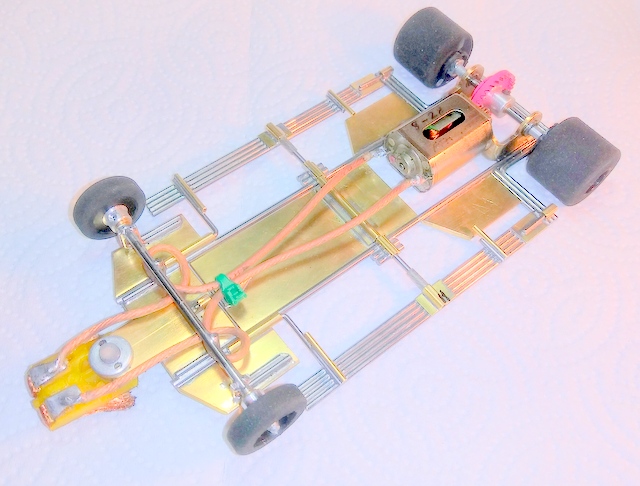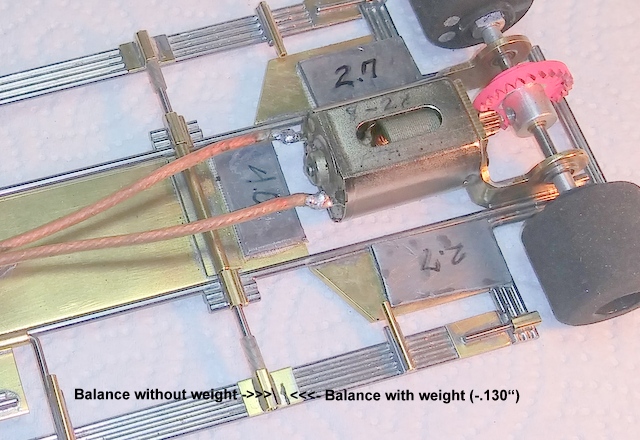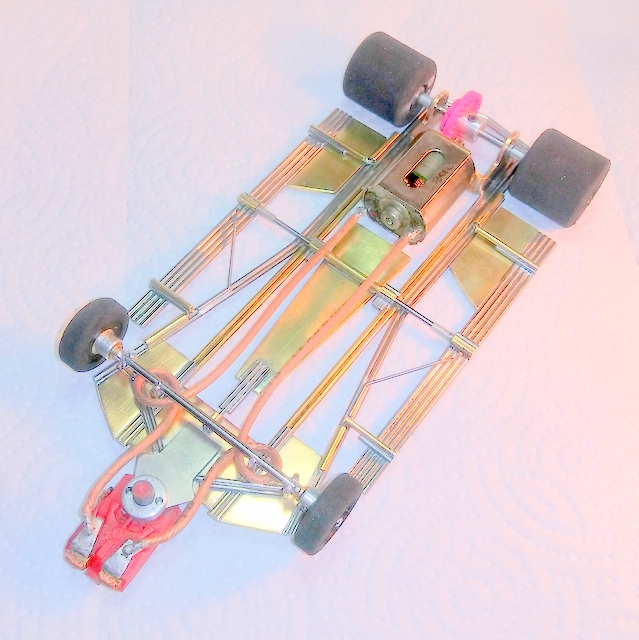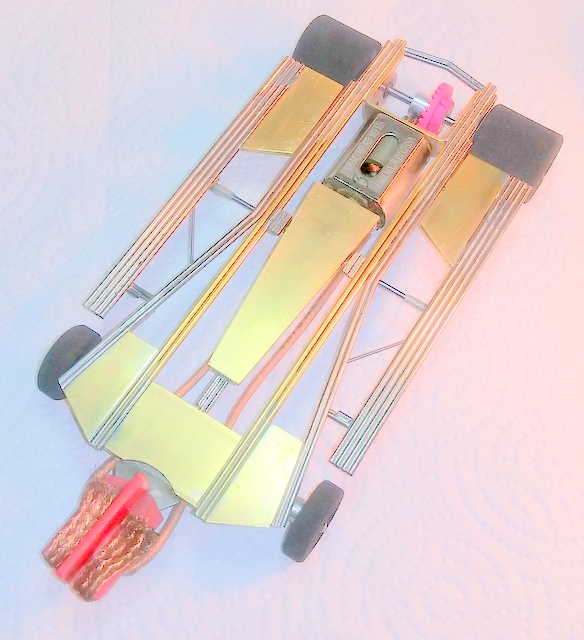Guide to chassis weight placement
#26

Posted 07 June 2018 - 09:11 PM
Probably balanced would be a safer bet, but, of course, feel free to try it both ways.
- Bud Denning and DavidR like this
Mike Swiss
Inventor of the Low CG guide flag 4/20/18
IRRA® Components Committee Chairman
Five-time USRA National Champion (two G7, one G27, two G7 Senior)
Two-time G7 World Champion (1988, 1990), eight G7 main appearances
Eight-time G7 King track single lap world record holder
17B West Ogden Ave., Westmont, IL 60559, (708) 203-8003, mikeswiss86@hotmail.com (also my PayPal address)
Note: Send all USPS packages and mail to: 692 Citadel Drive, Westmont, Illinois 60559
#27

Posted 07 June 2018 - 09:18 PM
My stock cars are all 8-27 or 28.
- tonyp and DavidR like this
#28

Posted 07 June 2018 - 09:19 PM
3/24/54-3/25/2023
Requiescat in Pace
#29

Posted 07 June 2018 - 09:20 PM
3/24/54-3/25/2023
Requiescat in Pace
#30

Posted 08 June 2018 - 12:07 AM
- Bud Denning likes this
A motor is only as fast as the chassis it's in.
Dominic Luongo
Like Dominator Custom Chassis on Facebook
NERR photos from 2012-April 2016
NERR photos from 2016 to now
#31

Posted 08 June 2018 - 04:52 AM
In most cases the charger will have more bite.
Anthony 'Tonyp' Przybylowicz
5/28/50-12/20/21
Requiescat in Pace
#32

Posted 08 June 2018 - 08:53 AM
3/24/54-3/25/2023
Requiescat in Pace
#33

Posted 10 June 2018 - 04:02 PM
3/24/54-3/25/2023
Requiescat in Pace
#34

Posted 11 June 2018 - 03:26 PM
It's very good that this thread was bumped and updated with new questions and responses. This is responding to the previous posts and is not intended to create any thread drift.
My process for selecting all JK true FK can motors including Falcon 7, Hawk 7 and RH motors (pre 7R7R...) involved an on-track break-in for 30 laps (never exceeding half throttle - only do this on an empty track), a full cool-down and then race it and a confirming check on the dyno after its first race. If it got hot during the half throttle break-in, it was not looking very good for that motor.
If it was not fast in Can Am, I would try it in a Stock Car using 9-28 gears. If it still wasn't fast, I would try a 8-26 in the Stock Car. I have found several RH's that liked that a lot; one has 9 competitive races on it and is still going strong with lots of motor brush still left!
Moral of the story; some motors like pulling a lot of weight with a "taller" gear ratio better than the lighter Can Ams. Oh, and this motor has spectacular numbers on the dyno SINCE moving it to a Stock Car and it definitely is NOT a 7R7R... motor. Just something else to try for those who run Stock Cars semi-regularly.
- Terry Tawney likes this
Sorry about the nerf. "Sorry? Sorry? There's no apologizing in slot car racing!"
Besides, where would I even begin? I should probably start with my wife ...
"I don't often get very many "fast laps" but I very often get many laps quickly." ™
The only thing I know about slot cars is if I had a good time when I leave the building! I can count the times I didn't on one two three hands!
Former Home Track - Slot Car Speedway and Hobbies, Longmont, CO (now at Duffy's Raceway), Noteworthy for the 155' Hillclimb track featuring the THUNDER-DONUT - "Two men enter; one man leaves!"
#35

Posted 11 June 2018 - 05:06 PM
The way I see it weight distribution and chassis design go hand in hand? If you design/evolve a chassis you design it with just enough weight in all the "right" places ,making it as light as possible and as close to either side of any specific rules regarding weight.
Any extra you have to add is often in the form of lead weight and that is normally stuck ontop of pans,nose pieces etc which is all above the center of gravity.
Get the weight distribution right, build that into your design, so no extra added weight raising the center of gravity , keeping the overall weight down , any "extra" weight is gonna slow you down .
Back to the subject matter of this thread:
My measurement of a wide variety of Retro Can Am chassis (others and mine) showed a CG location of 1.950 - 2.050 (2.000 +/- .050) inch forward of the rear axle centerline at our local Hillclimb track. As a matter of reference, a recent Bartos Can Am chassis tuned (weighted with lead for the Tom Thumb Hobbies King Track) to be on the long (forward biased) side of the above stated limit, at 2.070 in.
My most recent chassis was designed in a CAD system that has very good mass calculations of assemblies to determine the vertical CG location off the ground (as reliable as any method of measuring it such as the tilted chassis cosine methods used on 1:1 cars). With all components (completed ready-to-race - no added lead - seems to run very well without it) the CAD model showed the vertical height to be 0.230 in at 96 grams. (This design used .025 thick full side pans to drop the CG just a small bit over .031 thick brass).
Curious, I took the opportunity to weigh a painted GT Coupe body with the interior at 8 grams, estimating the CG location as .656 inches up (in Z) and at 2.156 ahead of the rear axle centerline. I added this component to the assembly and it shifted the CG upward by 0.035 in (0.265 with body) and forward by 0.026 (negligible).
Adding lead on top of the pans will lower the CG significantly because it is about as low as you can add it. The alternative (heavier pans at the same total chassis weight) leaves the CG even lower but not by a lot.
If you run at a track regularly and are happy with the way it runs (do not typically add or remove lead), then you could shift the weight down lower by taking the lead off and adding the mass to the pans to lower the CG (arguably, the better solution for better handling) and keep some of the punched-out (approx 1/4 in diameter) pieces of lead around for finer tuning.
I may add a post to this thread later after measuring a Stock Car body mass with interior and make a similar edit to an older Stock Car CAD design so we can all get a better sense of why Stock Cars handle like tanks - even at 150 grams running weight!
- NSwanberg likes this
Sorry about the nerf. "Sorry? Sorry? There's no apologizing in slot car racing!"
Besides, where would I even begin? I should probably start with my wife ...
"I don't often get very many "fast laps" but I very often get many laps quickly." ™
The only thing I know about slot cars is if I had a good time when I leave the building! I can count the times I didn't on one two three hands!
Former Home Track - Slot Car Speedway and Hobbies, Longmont, CO (now at Duffy's Raceway), Noteworthy for the 155' Hillclimb track featuring the THUNDER-DONUT - "Two men enter; one man leaves!"
#36

Posted 11 June 2018 - 05:41 PM
David:
I've run (and won) with my IRRA Stockcar many many times on Eddie's track and I've almost always run 9/28 or 9/27.
FYI...I run my Stockcar around 130 grams and due to their top-heavy nature I like to run the car a little on the loose side. If natural tires are too tight and treated are too loose you might want to try one of each. I've done that quite a few times to loosen the car up just a bit and it's worked well for me.
- DavidR likes this
Jay Guard
IRRA Board of Directors (2022-Present),
Gator Region Retro Racing Director (2021-Present)
SERRA Co-Director (2009-2013)
IRRA BoD advisor (2007-2010)
Team Slick 7 member (1998-2001)
Way too serious Retro racer
#37

Posted 12 June 2018 - 01:26 PM
As promised, the Retro Stock Car numbers (for those who care, also compare to Can Am numbers above):
Ready to race chassis without body is 129 grams that brings the CofG lower than a Can Am car in Z axis above ground plane at 0.149 (recall, front clearance is 0.050 in vs 0.015 for Can Am so half of the total mass goes up half the difference, or, 0.018 yet the CofG of the chassis is STILL lower than the Can Am chassis) and the X axis is 2.106 forward of rear axle centerline.
Chassis as raced with a 13 gram painted body and interior (assumed 0.956 in vertical and measured 2.056 forward of rear axle centerline) contributes to an aggregate CofG location in the Z axis is 0.224 (about where the ready-to-race Can Am car with body because, frankly, that's what works) and an X axis value of 2.130 forward of the rear axle centerline.
In summary, this confirms what we already knew but puts (in my feeble but educated mind) some numbers to it. The CofG of the stock car body is quite a bit higher than the Can Am body. Adding very low weight (at the bat pan level) quickly and significantly lowers the CofG. The surprise might be that the stock car chassis CofG is quite a bit lower than the Can Am chassis. Armed with this information, I am going to try mounting a Can Am body on a Stock Car chassis and see how it handles! Adding lead on top of the pans is just for getting the balance right.
Has anyone tried this?
- JimF, NSwanberg and Eddie Fleming like this
Sorry about the nerf. "Sorry? Sorry? There's no apologizing in slot car racing!"
Besides, where would I even begin? I should probably start with my wife ...
"I don't often get very many "fast laps" but I very often get many laps quickly." ™
The only thing I know about slot cars is if I had a good time when I leave the building! I can count the times I didn't on one two three hands!
Former Home Track - Slot Car Speedway and Hobbies, Longmont, CO (now at Duffy's Raceway), Noteworthy for the 155' Hillclimb track featuring the THUNDER-DONUT - "Two men enter; one man leaves!"
#38

Posted 13 June 2018 - 01:49 PM
I am going to try mounting a Can-Am body on a Stock Car chassis and see how it handles! Adding lead on top of the pans is just for getting the balance right.
Has anyone tried this?
Yes, I have tried it. Fairly often. I even raced a Stock Car chassis once with a Can Am body on it. If you try it yourself, I think you'll find that the biggest detriment to handling in these things is not at all the 4.5" WB.....it's the body. I also believe that the better weight placement on these cars is aft. Here are some examples currently being worked on and tuned for a couple of flat track races.
A pretty std frame for me, 125 gr as shown with no weight. This is too light for a flat track. This chassis has two brass weight tabs (~~ 5.0 gr. ea.) attached to the frame just ahead of the rear axle.
Same frame showing weight placement of about 9.5 gr. The two felt pen lines show the different balance points. The addition of this weight moved the balance point about .130" rearward. This is a good starting point for the flat track and works pretty well. Eventually the 4 gr. bit at the rear of the center plate will probably get split in two and moved to the rear weight tabs which currently hold 2.7 gr ea.
Here is a different approach. This car weighs 123 gr as shown and unweighted, the balance point is almost identical to the weighted example above. This was done by removing some weight from the nose assembly and reducing weight in the front part of the center weight. This chassis also uses brass weight tabs at the rear (5gr ea.) but in this case, they are on the pans not on the center section. At some point, I'll probably remove them from the pans and flip them to the center section to see what the difference is.
Given the effect of the heavy, stiff and tall body, I'm wondering if the weight on the pans might dampen the effect of the body? (don't know, but I'm about to find out I guess) This chassis also has some springs to further dampen the pan movement. I think I probably overdid it with the springs but they'll come off easily enough. This chassis has yet to roll.
- Tex and NSwanberg like this
#39

Posted 16 June 2018 - 09:04 PM
- NSwanberg and Rich Joslin like this
3/24/54-3/25/2023
Requiescat in Pace
#40

Posted 17 June 2018 - 08:20 AM
Good work David.























